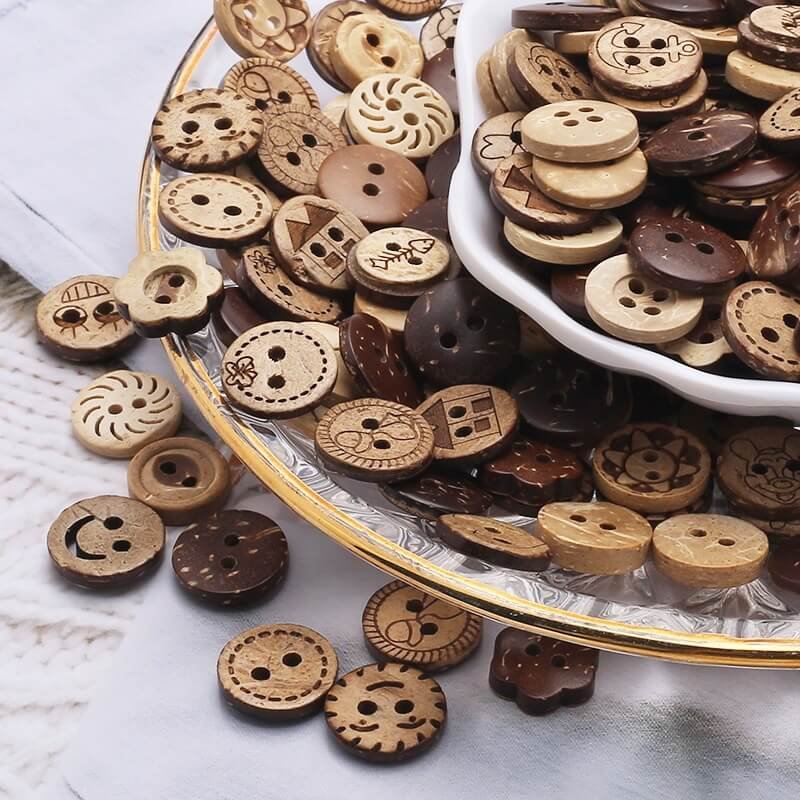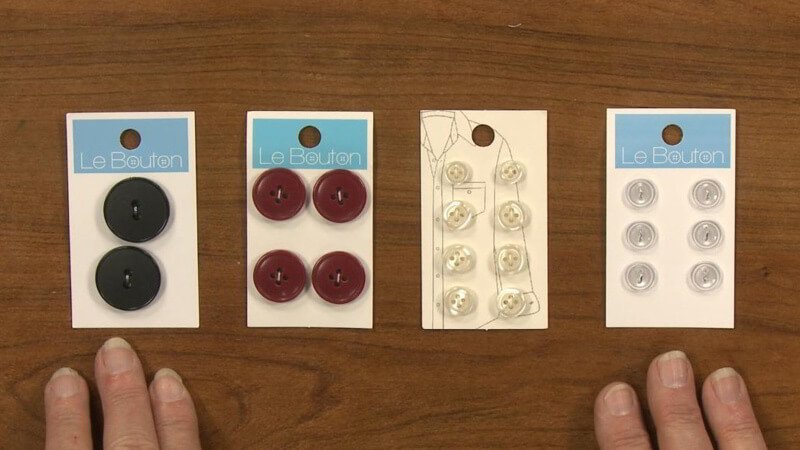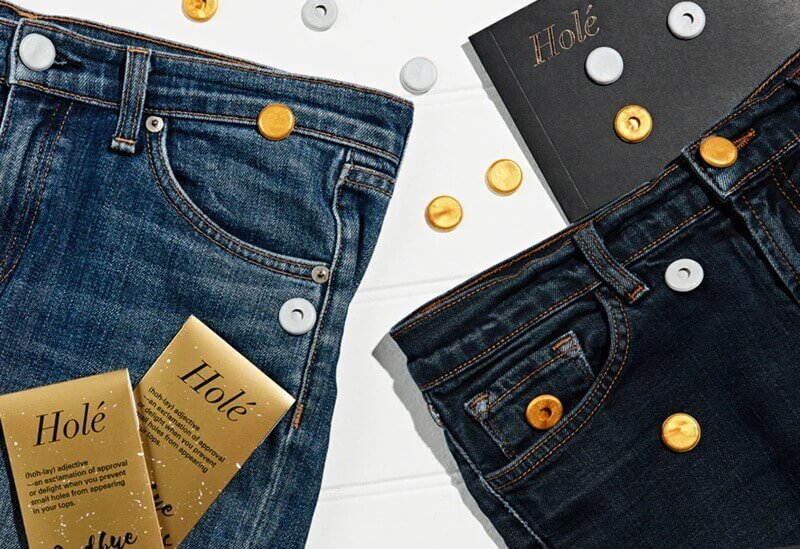Choosing the Right Buttons for Clothes: Types, Materials and Expert Tips
Buttons are far more than mere fasteners; they are integral design elements that significantly impact a garment’s overall aesthetic and functionality. However, the sheer variety of buttons available can make selection feel daunting. Are you facing challenges in choosing the right buttons for your clothing line?
By understanding the nuances of button selection, you’ll gain the knowledge to make informed decisions, find inspiration for your designs, and ensure the longevity of your garments. Let’s dive into how to choose the right buttons for lasting and well-designed products.
Buttons are far more than simple fasteners; they are integral to both the functionality and the visual appeal of clothing. From securing garments closed to serving as key decorative accents, buttons play a vital role in apparel design.
However, the sheer variety of clothing buttons available today can be truly overwhelming. For designers, small business owners in the clothing industry, and passionate DIY creators alike, navigating this vast selection to choose the perfect button can be a daunting task.
This comprehensive guide is designed to be your expert resource, demystifying the world of garment buttons. We will explore the diverse types of buttons, their materials, and their ideal uses, providing you with the knowledge and insights needed to make informed choices and elevate your sewing and design projects.
Whether you are seeking the perfect fashion buttons to complete a high-end design or practical sewing buttons for everyday garments, this guide will equip you with the expertise to select buttons with confidence and style.

2. Buttons by material: Choosing the right fabric for your needs
The material of a button significantly impacts its look, durability, and suitability for different garments. Let’s explore the diverse world of button materials to guide your selection.
Metal buttons are celebrated for their durability and inherent style. Crafted from various metals, they come in diverse shapes and finishes, from classic flat designs to decorative shanks and studs. Their robustness makes them ideal for jeans, jackets, and sturdy workwear, where buttons need to withstand significant wear and tear.
For selecting metal buttons, consider the metal type to match your garment’s aesthetic and intended use. Brass buttons offer a vintage or classic feel, while stainless steel buttons provide exceptional durability and a modern look. Always prioritize rust-resistant metals, especially for garments that will be frequently washed or exposed to the elements, ensuring longevity and maintaining the button’s appearance.
Shell buttons exude natural elegance and a subtle sheen. Made from real or imitation shell, they possess a unique glossy texture that elevates garments. Their refined appearance makes them a favored choice for high-end shirts, sophisticated suits, and delicate blouses, adding a touch of understated luxury.
When choosing shell buttons, be aware of the difference between real and imitation shell. Real shell buttons are naturally beautiful but can be more fragile and require gentle care. Imitation shell buttons offer a more durable and often more affordable alternative. Regardless of the type, shell buttons are delicate and should be treated with care. Avoid harsh chemicals and consider hand-washing garments with shell buttons to preserve their delicate beauty.
Plastic buttons are the workhorses of the button world, prized for their versatility and affordability. Encompassing a wide range of plastics like polyester, resin, ABS, acrylic, and nylon, they can be molded into virtually any shape and dyed in countless colors. Their cost-effectiveness and adaptability make them suitable for a vast array of clothing, particularly general everyday wear and children’s clothing.
Within plastic buttons, different plastic types offer varying properties. Polyester buttons are known for their durability and resistance to wear, while acrylic buttons can mimic the look of glass or gemstones with their clarity and shine. When considering plastic buttons, explore eco-friendlier plastic options, such as recycled or bio-based plastics, to align with sustainability values without sacrificing versatility or affordability.
2.4 Natural & sustainable materials: Wood, coconut, horn, antler
For designers and brands prioritizing eco-friendly options, buttons crafted from wood, coconut, horn, and antler present a compelling choice. These materials are naturally sustainable and lend an organic, earthy aesthetic to clothing. Wooden buttons, for instance, exude a warm, rustic charm that complements craft projects and knitted garments beautifully.
Coconut buttons, recognized for their inherent texture and biodegradability, are an excellent choice for woolen coats and sweaters. Horn and antler buttons, each with its own unique texture and markings, contribute a distinctive, earthy element often found in rustic or heritage-style clothing.
When selecting natural buttons, it’s worth considering the origin and sustainability of the materials. Look for options made from responsibly harvested wood, and ensure that horn and antler are ethically sourced. Also, keep in mind the specific care requirements of natural materials. Wooden buttons, for example, might be sensitive to excessive moisture, meaning gentle washing and careful drying are essential to preserve their appearance and longevity.

For adding decorative and textured elements, fabric, leather, and pearl buttons offer a softer touch. Fabric buttons, often crafted from felt, linen, satin, cotton, or wool, provide a customizable and skin-friendly option, perfect for clothing, bags, and DIY decorations.
Leather buttons bring a retro or rugged feel, well-suited for jeans, jackets, and leather products. Pearl buttons, whether imitation or faux, offer an elegant and beautiful touch, ideal for shirts, sweaters, and decorative accents.
When working with these decorative buttons, consider the specific characteristics of each material. For fabric-covered buttons, choose fabrics that complement your garment and are easy to work with. Leather buttons may require special care to maintain their texture and prevent drying. Pearl buttons, especially imitation versions, can be delicate and may need gentle handling and washing.
If you’re looking to add a truly unique and artistic element to clothing, ceramic and glass buttons offer a beautiful solution. They are often handcrafted and available in a vast range of shapes, colors, and designs, making them perfect as distinctive accents. Because of their fragility, garments featuring ceramic or glass buttons are best reserved for special occasions and require careful handling to prevent damage.
Rubber buttons are defined by their softness and bendability, making them a safe and practical choice, especially for certain types of clothing. Their gentle nature makes them ideal for children’s clothing, casual shirts, t-shirts, polo shirts, sweatshirts, and uniforms, where comfort and safety are paramount.
The primary advantage of rubber buttons is their safety, particularly for children’s wear, as they are soft and pose less of a risk compared to harder button materials. They are also well-suited for casual garments where a softer, less rigid button is desired. Consider rubber buttons when comfort, safety, and a relaxed aesthetic are key requirements.
3. Buttons by function: Fastening and beyond
These buttons are primarily designed for secure functional fastening. Snap buttons utilize interlocking discs for easy closure, ideal for garments needing frequent opening and closing. Rivets and jeans buttons are robust, often hammered or pressed in place, providing permanent, heavy-duty closures for denim and workwear. Toggle buttons, fastened through loops or slots, offer a distinctive, often rustic closure for coats and outerwear.
When selecting functional fasteners, consider the fabric weight and garment style. Heavier fabrics and robust garments benefit from the strength of rivets or jeans buttons, while lighter fabrics and casual wear may suit snap or toggle buttons. For snap buttons and rivets, specialized tools like snap pliers or rivet setters are often necessary for proper and secure application.
Flat buttons, with 2 or 4 holes, are the most common and versatile type of sew-through button. Easily attached by sewing directly through the holes, they are suitable for a wide range of garments, from shirts and blouses to dresses and cardigans. Their simplicity and ease of sewing make them a staple in garment construction.
Choosing between 2-hole and 4-hole flat buttons depends on the fabric and desired security. Four-hole buttons generally offer a more secure attachment, especially for thicker fabrics or areas of stress. Employing techniques like shank creation with thread when sewing flat buttons onto thicker fabrics ensures the garment lays smoothly and the button is securely fastened without puckering.

Shank buttons feature a protruding loop or shank on the back, creating a slight elevation from the fabric surface. This design gives a more three-dimensional look and is often favored for coats, jackets, and decorative applications. Shank buttons add a touch of sophistication and are less likely to pull or distort delicate fabrics compared to flat buttons on heavier materials.
Various shank types exist, including metal loops, plastic bars, or thread shanks. Select shank types based on fabric thickness and desired aesthetic. The shank design inherently helps prevent fabric puckering, as it provides space between the button and the garment, allowing the fabric to drape naturally.
This category encompasses buttons primarily used for aesthetic enhancement. Enamel buttons offer vibrant colors and a glossy finish. Beaded buttons incorporate beads for texture and visual interest. Covered buttons allow for fabric customization. Knot buttons provide a unique, often handcrafted look. Lapel buttons serve as branding or decorative accents.
Decorative buttons are powerful tools to enhance garment style and branding. Lapel buttons, for instance, can subtly promote a brand or add a distinctive detail to jackets and blazers. DIY enthusiasts can utilize covered buttons to create custom designs matching specific fabrics or patterns, adding a personalized touch to their creations.
Certain button types are less frequently encountered in mainstream clothing but serve specialized applications. Hook buttons offer a concealed closure, often used in waistbands or areas where a hidden fastening is desired. Screw-on buttons provide a very secure, permanent attachment, suitable for heavy-duty items. Studs and press buttons are often used in leather goods or for specific industrial applications.
These less common button types are specialized due to their specific functionality or application methods. Hook buttons are valued for their discreet closure, while screw-on buttons prioritize ultimate security. Understanding their niche uses allows for informed choices when standard button types are not suitable for particular garment needs.
4.1 Consider the garment type and fabric
The type of garment and its fabric are primary determinants in button selection. For heavy coats, prioritize durable buttons capable of withstanding stress and wear. Delicate blouses require lightweight buttons that won’t weigh down the fabric or distort the drape. Jeans necessitate robust rivets or jeans buttons designed for denim’s strength and frequent use.
As a rule of thumb, let fabric weight and weave dictate your button choice. Heavier fabrics demand stronger button attachments and more substantial buttons. Conversely, lighter, more fluid fabrics pair best with lighter buttons to maintain the garment’s intended silhouette and movement.

4.2 Functionality vs. aesthetics
Strive for a harmonious balance between functionality and aesthetics when choosing buttons. While buttons are essential functional closures, they also contribute significantly to the garment’s overall design.
Expertly chosen buttons should complement, not overpower, the garment’s design. Prioritize functionality for areas requiring secure closures, such as front plackets or cuffs. Emphasize aesthetics when buttons serve as decorative elements, enhancing the garment’s visual appeal.
4.3 Button size and placement
Button size should always be proportional to the garment and the buttonhole spacing. Oversized buttons on a delicate blouse can appear clumsy, while undersized buttons on a heavy coat may look inadequate and feel insecure.
Establish size guidelines based on the garment’s scale. Larger garments, like coats and jackets, can accommodate larger buttons. Smaller garments, such as shirts and blouses, typically require smaller, more delicate buttons. Button placement is equally crucial, impacting both garment fit and function. Accurate and thoughtful placement ensures proper closure and comfortable wear.
4.4 Button color and style harmony
Button color and style should harmonize with the garment’s overall design. Consider color matching buttons to the fabric for a subtle, unified look, or use color contrast to create visual interest and highlight button details. Style consistency is also key – buttons should align with the garment’s overall aesthetic, whether classic, modern, or avant-garde.
Buttons are powerful tools to enhance garment design. Carefully consider your color palettes and the intended garment style (classic, modern, bohemian, etc.) when selecting buttons. The right buttons will seamlessly integrate with the design, elevating the finished piece.
4.5 Durability and care
Prioritize durability in button selection to ensure garment longevity. Choose buttons made from robust materials appropriate for the intended garment use and care requirements. Always consider button care instructions in relation to the garment’s care.
Durability directly translates to garment longevity. Check button materials for resistance to wear, washing, and potential damage. When selling or gifting garments, provide clear care labels that include button care advice, ensuring customers understand how to maintain both the garment and its button embellishments for lasting wear.

For everyday wear, metal, polyester, and nylon buttons are generally the most durable choices. These materials are known for their resistance to wear and tear, holding up well to regular use and washing. Metal buttons offer robustness and style, while polyester and nylon buttons provide excellent durability at an affordable price point, making them practical for frequently worn garments.
When selecting buttons for shirt cuffs, remember that cuff buttons are typically smaller than those used for front closures. Consider the wrist size and cuff style of the shirt. Buttons should be proportional to the cuff and allow for comfortable movement without feeling too tight or restrictive. Smaller, flatter buttons are often preferred for cuffs to maintain a streamlined and comfortable fit.
Yes, decorative buttons can certainly be used for functional closures, adding a stylish touch while serving a practical purpose. However, it’s essential to ensure secure attachment and sufficient closure strength when using decorative buttons functionally. Choose decorative button styles that are not only aesthetically pleasing but also practical for fastening and capable of withstanding the intended use of the garment.
To find unique and high-quality buttons for your clothing line, explore a variety of sources. Start by investigating specialized button suppliers who often offer a wide range of materials, styles, and finishes. Craft stores can be excellent resources for more common and decorative options.
Online marketplaces provide access to a vast selection from diverse vendors, allowing you to discover unique and vintage buttons. For truly distinctive finds, consider seeking out specialized button vendors or even artisans who create handcrafted buttons.
General care for buttons includes gentle washing of the garment and avoiding harsh chemicals that could damage button finishes or materials. However, material-specific care is crucial for maintaining the appearance of different button types.
For example, shell buttons should be protected from harsh chemicals and excessive moisture. Wooden buttons should be shielded from prolonged soaking to prevent warping or damage. Always check garment care labels for specific instructions and advise your customers on appropriate button care to ensure longevity.
6. Packlove – Providing garment accessories for your brand
With over 8 years immersed in the garment industry, Packlove understands that every detail matters, from the perfect button to the final packaging. Specializing in garment accessories like labels, tags, zipper bags, and poly mailers, we bring a wealth of experience to support your brand’s needs. Our expertise extends to understanding the nuances of garment components, including button selection, and we are dedicated to providing businesses with informed advice to enhance their product offerings.
Beyond buttons themselves, Packlove offers comprehensive garment branding and packaging solutions. Our range of labels, tags, zipper bags, and poly mailers are designed to perfectly complement your button choices and overall garment design, creating a cohesive and professional brand identity.
Whether you are seeking advice on sourcing buttons or need high-quality branding and packaging to showcase your button-embellished garments, Packlove is your partner in garment success.
For more information on our services and how we can support your brand, please visit Packlove. Contact us today to discuss your garment accessory needs and let us help you elevate your brand presentation.
Read more:
From the most functional fastener to the most exquisite embellishment, buttons are undeniably diverse and vital components in the world of clothing. Understanding the nuances of button materials and functions, as explored in this guide, is key to making expert choices that truly enhance your garments.
For designers and businesses alike, mastering button selection is an investment that elevates both the aesthetic appeal and the practical value of your creations. As the fashion landscape evolves, remember to stay updated on emerging button trends and material innovations, ensuring your designs remain both stylish and functionally superior.






















